I. What are the Structure and Function of Antibodies?
Who would’ve thought that a major part of your adaptive immune system and arguably its most important component are Y shaped proteins that simply are carried through blood serum! Antibodies have become not just an important topic of study for understanding how the immune system works, but also have become so significant in the role of treatment and therapeutics.
Though they’re simple in design, structure, and function, antibodies are crucial in the immune response not just in regards to suppressing and eradicating a pathogen infection, but also the development of immunological memory as we’ve discussed. Let’s go ahead and delve into the various intricacies of antibodies!
II. The Structure and Function of Antibodies
It’s important to remember that antibodies are produced by B cells, particularly plasma cells which are specialized B cells produced as a result of clonal selection. Additionally, antibodies (also called immunoglobulins) are simply B cell receptors which have been released by the B cells and are now soluble in the bloodstream to fight infection.
A. Antibody Structure
The structure of an antibody is relatively simple if we break it down via what binds to the antigen and what doesn’t. The antibody has 2 main regions: 1) Fab (antigen binding site/region) and 2) Fc (constant region).
As the name implies the Fab region has a unique arrangement of amino acids which can bind to various pathogenic antigens while the Fc region remains relatively constant in its amino acid combination; however, there are different isotypes of the Fc constant region as we’ll discuss in a bit.
The Fab region is composed of 2 protein subunits: a light and heavy chain which are connected to each other by disulfide bonds — a total of 2 light and heavy chains are present because there are 2 Fab regions as shown below. The Fc region is entirely composed of the 2 heavy chains also connected via disulfide bonds and can change their isotypes to be specific for a certain kind of infection.
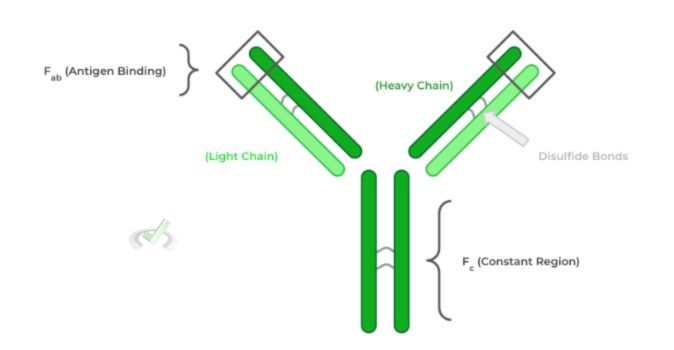
As we mentioned, though the Fc region remains relatively constant in regards to amino acid arrangement, there are various isotypes of the Fc region which can be selected to generate a more specific type of immune response for a more specific type of infection.
There are 5 main types of Fc regions (also called Ig Isotypes) which can be memorized by the acronym “GAME D”: IgG, IgA, IgM, IgE, and IgD. The only real significance for the IgM isotype is that it's the first isotype to be produced in an infection before specific Ig selection can take place.
The IgE antibody is primarily the main antibody associated with eradicating parasitic infection and generally allergies. The IgA antibody is primarily associated with the protection of mucosal surfaces such as the GI and respiratory tract. Finally, the IgG isotype is primarily considered the immunoglobulin with the strongest response to bacterial and viral infection!
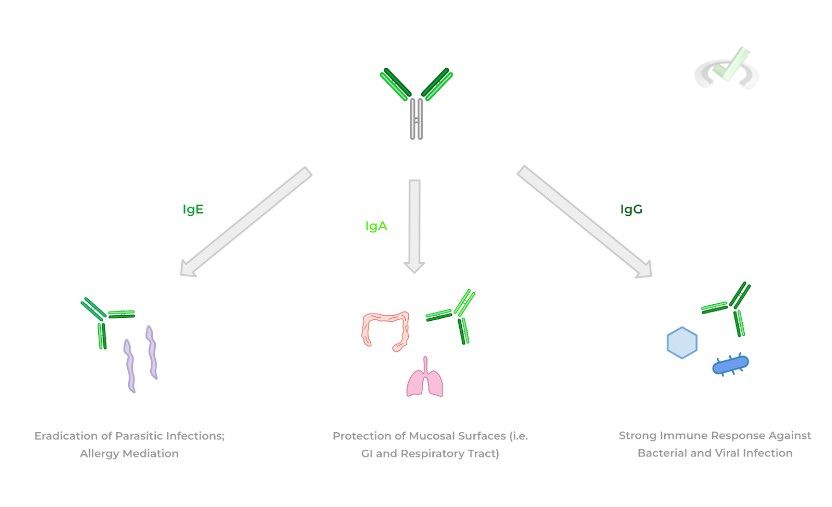
B. Antibody Function
The strong immune response elicited by antibodies is a testament to the wide variety of mechanisms by which antibodies suppress pathogenic infection. In general, there are 3 main ways that antibodies help the body to mount an immune response: 1) neutralization, 2) opsonization, and 3) complement system activation.
I. Neutralization
In its simplest term, neutralization involves the engulfing of antibodies around a pathogen with the idea of encasing the pathogenic organism in order to prevent it from attacking host tissue. If the microorganism is surrounded by antibodies, it can’t enact its pathogenic damage to host tissue which allows for suppression of the immune response.
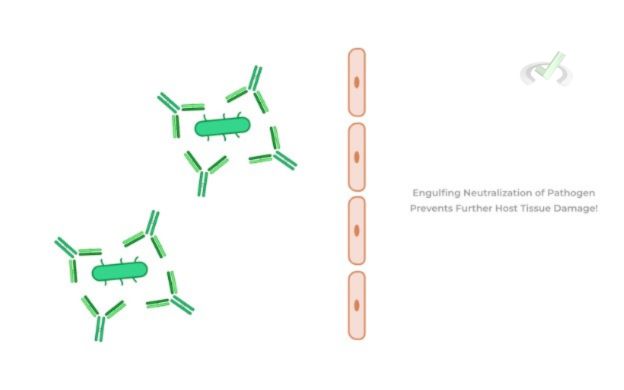
II. Opsonization
When you think of opsonization, try to associate the “p” in opsonization with the phagocytosis of macrophages, as after the binding of an antibody to a pathogen, the pathogen-antibody complex is recognized by macrophages and is phagocytosed killing the pathogen and preventing further pathogen damage!
This phagocytosis is accomplished via surface receptors located on the macrophage which can recognize the Fc constant region of the antibodies which stimulates phagocytosis — think of this as almost receptor mediated phagocytosis!
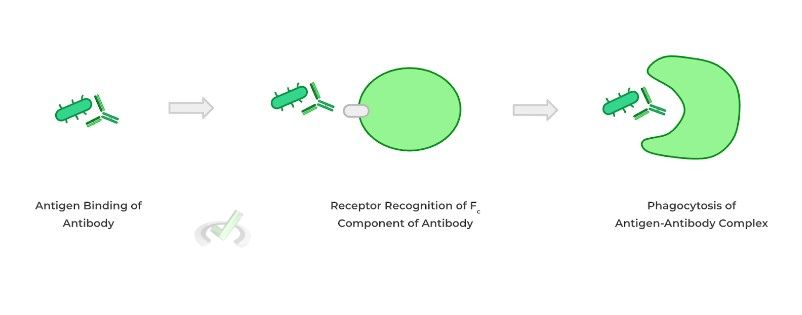
III. Complement System Activation
Finally, antibodies are also involved in the activation of the complement system which comprises various complement proteins that also have an active though fairly smaller role in the immune response!
Though the various specifics and pathways of the complement system go beyond the scope of the MCAT, just know that their activation can elicit further opsonization via the complement proteins or pore formation which can cause lysis in microorganisms!
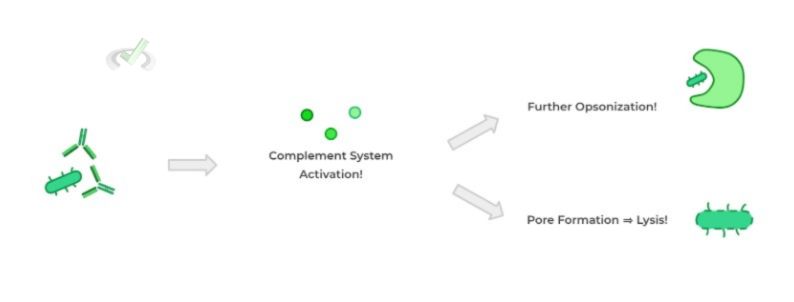
III. Bridge/Overlap
As we mentioned above, we stated that antibodies are composed of light and heavy chains which come together to form one protein. As such, antibodies are a good example of a protein with quaternary structure — let’s go ahead and review what makes antibodies proteins with quaternary (4˚) structure.
I. Quaternary (4˚) Structure of Antibodies
Recall that quaternary structure refers to a collective protein with multiple protein subunits! Essentially, they are built off of tertiary (3 ̊) protein structures, which come together to eventually form the quaternary, multi subunit protein.
In this case, the individual protein subunits are the light and heavy chains which represent the tertiary structure that come together via the presence of covalent, disulfide bonds to form the full antibody with quaternary structure. If you want another example of quaternary structure in physiology, the hemoglobin molecule is a great example!
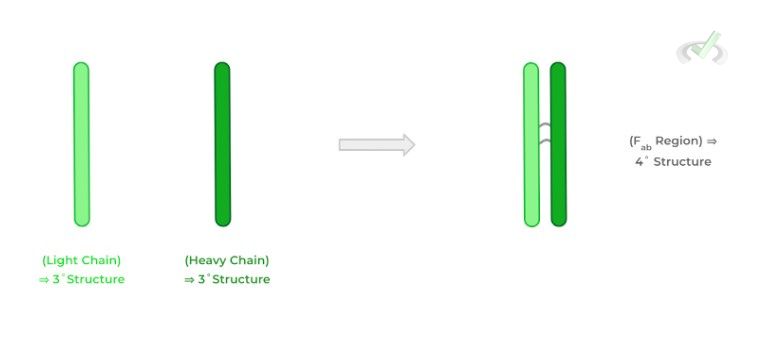
IV. Wrap Up/Key Terms
Let’s take this time to wrap up & concisely summarize what we covered above in the article!
A. Antibody Structure
The antibody structure is composed of a Fab region, which is the antigen binding site, and the Fc region, which is a constant region which can multiple different isotypes. The Fab region is composed of one light chain and one heavy chain that varies in amino acid sequence in order to maximize the recognition capability of various antigens!
The Fc region has many different isotypes that can be switched in order to make an immune response more specific for a particular pathogen. These include IgG, IgA, IgM, IgE, and IgD which can be remembered via the mnemonic “GAME-D”.
The IgE isotype is particularly associated with the eradication of parasitic infections and allergies. The IgA isotype is associated with the protection of mucosal surfaces such as those within the GI and respiratory tract. Finally, the IgG isotype is primarily regarded as eliciting the strongest immune response for bacterial and viral infection.
B. Antibody Function
There are 3 main mechanisms by which antibodies can elicit an immune response: 1) neutralization, 2) opsonization, and 3) complement system activation.
Neutralization involves the engulfing of the pathogen by antibodies to prevent further host damage. Opsonization results in the phagocytosis of the pathogen after antibody bonding via receptor recognition of the Fc constant region. Complement system activation allows for the promotion of further opsonization and pathogen lysis via pore formation!
V. Practice
Take a look at these practice questions to see and solidify your understanding!
Sample Practice Question 1
Complete the statement.
Phagocytes, particularly macrophages, have receptors which recognize the ______________ region of the antibody which allows for phagocytosis in a process called ______________.
A. Fab Region, Opsonization
B. Fab Region, Neutralization
C. Fc Region, Neutralization
D. Fc Region, Opsonization
Ans. D
This process describes opsonization where after the antibody binds to the pathogen via the Fab region, the surface receptors located on the macrophages allow for recognition of the unbound Fc region to allow for phagocytosis in a process very similar to receptor mediated phagocytosis.
Sample Practice Question 2
Streptococcus pyogenes is a type of gram positive, cocci bacteria which is a common cause of respiratory infection commonly called strep throat. As such, which of the following Ig antibody isotypes would most likely be expressed in high abundance during the course of the infection?
I. IgE
II. IgG
III. IgA
A. I only
B. II only
C. I and III
D. II and III
Ans. D
Recall that IgG is the most prominent immunoglobulin isotype that combats viral and bacterial infection, similar to what’s seen in this case. In addition, because S. pyogenes is also primarily an infection of the respiratory tract, you can also expect a high amount of IgA isotypes due to their role in the protection of mucosal surfaces.







 To help you achieve your goal MCAT score, we take turns hosting these
To help you achieve your goal MCAT score, we take turns hosting these 





















 reviews on TrustPilot
reviews on TrustPilot